You can pay 500 rupees (US$10) and take a guided tour of Dharavi, a Mumbai slum. But should you take a tour of a Mumbai slum? Aren’t you basically treating human suffering as a tourist attraction?
Our guidebook mentions an outfit called Reality Tours that undertakes tours in a respectful manner, with no photography allowed, and claims to donate 80% of after-tax profits to an NGO. It’s the slum tour you can feel warm and fuzzy about!
As they say on their website: “One of the aims of the tours is to dispel the myth that Dharavi is simply a place of squalor and (extreme) poverty. The reality is that Dharavi, despite its limitations, is different from that… In Dharavi one sees the dignity, fortitude and enterprise of the people, where they are able to work and live in very small areas, with a very high density of population, and yet able to host a plethora of small scale industries.”
In my short time in Mumbai, I’m trying to get as clear a picture of this place as possible. I decided to take a tour.
Ironically, I ended up booking it with a different company, Visit India. Their office is conveniently located exactly where Lonely Planet shows the Reality office, and while the boys at Visit India didn’t say they were Reality Tours, they didn’t disabuse me of the notion either. “Oh, yes, sir, we give some of our profits to NGOs, too,” they claimed when I eventually figured this out. However, my time was getting tight: if I didn’t take a tour in the next hour I probably wouldn’t, so I signed up with the charlatans.
I was steamed over being deceived and concerned that I was the only person signed up for the tour. I felt better when another American, Casey, joined the tour, and when our guide, Shailesh, said that he is an actual resident of Dharavi.
My skepticism immediately kicked in and wondered if that was true, yet he said he would take us to his home. He worked for Reality for a year, he told us, but wasn’t happy with how they run their business. How can they give 80% of their profits to an NGO when they have fancy offices and multiple air-con vehicles? He said that the kindergarten they claim to support is seldom open, and that his new employer truly gives a reasonable amount of profits to help the slums. Deception and confusion may have led me to a better tour.
We got off the train at Mahalaxmi, crossed the bridge, and there it was: Dharavi. Shailesh allowed us to take photos at a few points during the tour, so I can show you the view from the overpass.
As we descended the steps and finally set foot in Dharavi, a wave of ordinariness washed over me. This main street was just like any other crowded market in Mumbai. Masses of people, workers hauling packages in every direction, motorbikes snaking past pedestrians. I expected my white skin to shine like a beacon, announcing, “HEY, FOREIGNERS OVER HERE”, but no one seemed to care.
Though we (and the Indian government) call it a “slum”, Dharavi is not a ramshackle collection of cardboard shacks put up last Thursday. It’s been around for generations, long enough for someone like Shailesh to grow up here. It’s organized enough that Danny Boyle could shoot scenes for Slumdog Millionaire here. This is a functioning mini-city with a population of over 600,000- perhaps as many as a million- in a space of 1 square mile. (My hometown of Milwaukee somehow crams 600,000 people into 96.12 square miles.) The businesses that operate in Dharavi are said to and add upwards of US$500 million to the Indian economy.
Can that be right? Let’s go see for ourselves.
From the main street, we walked into an alley and smack dab into the slum economy. Bags of plastic bottles over here. A man crushing a circuit boards and extracting tiny bits of metal over there. A soupy grey liquid running beneath (hopefully between) our feet.
First stop on the tour: plastic sorting. The scruffy bottle collectors we see on the streets bring their haul here and sell it to the sorters. Before us, the room was piled high with clear, white, and green bottles. A few people crouched on the floor, examining each bottle individually and tossing it into one of several piles, as the plastic needs to be sorted by type and quality. That’s it. That’s what they do here. Shailesh said we’d see more of the process later on. The workers were friendly with him, smiling and chatting when we arrived.
Next door, a man was dipping old paint cans into a vat of murky liquid. Shailesh explained that the chemical bath washes the logos off the cans, after which the dents can be hammered out and the cans used for new paint. Wincing, I said, “It’s dangerous for him to dip those cans into toxic chemicals with his bare hands.” “Yes,” replied Shailesh.
Then we were off to- hey, here comes Reality Tours. A guide in a Reality Tours shirt walked by, shook hands and joked with Shailesh, and led his group of eight or so westerners along.
Moving on, we passed a man sitting on the ground, unwrapping music cassettes*. He removed the shrinkwrap, pulled out the paper sleeve and set the rest aside, presumably to harvest the plastic. I always wondered what happened to unsold cassettes.
* A cassette is an audio delivery medium from an earlier, more primitive time.
Back to those plastic bottles: now they were being shredded by machine and melted into vats of plastic goo. More later.
Off to the bakery, where four guys were making puff pastries. Blackened trays, arranged with 36 pastries each, were pushed into a huge oven. Boy, was it hot. I could feel it from outside- what must it be like in that room? I took a moment to study the worker putting ten pastries at a time into plastic bags. He sat barefoot in the dingy, black room, handling the food (and trays and god-knows-what-else) with his bare hands. Ten more in a bag, ready for sale at your local street vendor.
Finally, the rest of the story on those plastics. The melted plastic goo is colored and run through a machine that squeezes into long plastic strands. The strands cool and harden quickly, and another machine cuts them into tiny plastic pellets. Voila, various color pellets that are then sold to local factories. I asked for a few pellets to take home with me. My slum souvenirs.
What about that word, “slum”, I asked Shailesh? He doesn’t like the word but didn’t offer an alternative. Of course, the derogatory term “slumdog” rolls off of everyone’s tongues since Slumdog Millionaire became a worldwide blockbuster. Shailesh crinkled his nose at mention of the movie. Say “Dharavi” and everyone thinks of that movie. I hear ya: whenever we mention our hometown of Milwaukee, everyone thinks of beer. (Standing in a London music store* a decade ago, I told the Pet Shop Boys I was from Milwaukee and Neil Tennant said, “Oh, where the beer comes from.”)
* A music store was a place to purchase music-related media in an earlier, more primitive time. SEE ALSO cassette.
This is apparently a location used in Slumdog Millionaire, when the younger version of our hero is fleeing the police. I’m looking forward to scouring the DVD for it when I get home.
Far from being a “slumdog”, Shailesh reports that he is one year away from finishing a chemistry degree at a nearby college. Besides giving slum tours for the past three years, he also arranges cooking tours, market tours, and Bollywood studio tours.
We saw more businesses churning away down the dark alleys of Dharavi. Middle-aged women pumping the foot pedals of sewing machines, turning out t-shirts. Teen boys filing down the rough edges of a component for an industrial food processor. A room full of… bricks? No, that’s soap; workers cut the slabs into smaller and smaller squares, then wrap them in paper for sale at the markets and use at the famed Dhobi Ghat laundry. A pile of scrap leather being turned into bags and wallets. Seeing some finished leather goods in a display case, I thought, here it comes: the big sales pitch. But no one asked us to buy anything- they just kept working.
Always a line of people… sorting, filing, grinding, loading, unloading. Often on the floor, doing repetitive tasks in uncomfortable positions. Always in dingy conditions, surrounded by soot-covered walls, toxic chemicals, heat, noise. Always without a shred of protective gear.
“Now we will visit the residential area of Dharavi,” said Shailesh, and led us down a narrow alley. A very narrow alley. Bumping his shoulders along the wall, Casey muttered, “Whoa”. The makeshift houses seemed to wrap around us, blotting out the daylight with their corrugated metal roofs. I remember passing a doorway and seeing a ladder to the second floor, a man asleep at the top. The sounds of kids playing echoed through tight passageways.
Stepping into a pool of daylight, Shailesh explained that the government supplies 24 hours of electricity and 3 hours of water each day (hence the large buckets for collecting water while you can). Every family in Dharavi, he said, receives a monthly electric bill. I asked how it is even possible to track that, but the question was lost on Shailesh. He said the electric wires are dangerous in the monsoon season. Uh yeah, I figured that.
We emerged from the claustrophobic alleyway into a courtyard full of garbage, which also functions as a children’s playground. As always, cricket games were in full swing. Kids ran up to us and spoke to us in English: hello, how are you, where are you from? I assumed they would ask for money (we’re standing in a slum, after all), but none did. They just ran back to their games. It began to dawn on me that more people have smiled and said hi to me in the slums that anywhere else in Mumbai.
The public toilets are here, too. With five or six people living in every home, Shailesh explained, the bathroom queue in the morning is quite long, and some people use the open ground (not unique to the slums, I’m afraid). A passerby called the Big Man high-fived Shailesh and shared a laugh.
Rising up beside the dump/playground was an apartment building, built by the government to rehabilitate the slum. The former residents of that land received a 225 square foot flat, and the private company developing the area was permitted to sell two floors worth of space to outsiders (new housing in Mumbai is scarce and therefore lucrative). This is a template the government hopes to repeat to address slum overcrowding, but some residents aren’t happy with maintenance costs, the lack of space to run a business, or the fact that they had more space before the rehab.
A few more turns and we arrived in Shailesh’s supposed neighborhood. However, he said, there was a wedding in progress today, and we wouldn’t be able to visit his home. Instead, Casey and I were welcome to walk to the end of this row and back, noticing the pottery his people are famous for along the way. As we finished our self-guided loop, we encountered Reality Tours coming the other direction. So, is this really Shailesh’s ‘hood, or just the standard pottery stop on every tour?
With the tour winding down, Shailesh addressed some broader issues. He noted that there are slums everywhere, including, he has heard, one in the United States (I blurted out “more than one”). Slums in places like Nairobi and South Africa are dangerous, drug-infested places. In Dharavi, he told us, it is safe. He stressed that despite historical conflicts (like the 1960 riots), Hindus and Muslims get along in Dharavi. He pointed out the Muslim decorations strung across an alleyway, and a Hindu business that churns out wooden Muslim shrines. Shailesh says he himself speaks five languages, including the “Muslim language”. Mirroring the Reality Tours line, he encouraged us to think of Dharavi not with pity, but with hope for the thousands of people working to pull their families out of poverty.
Or something like that. As we parted ways at the train station, all I could think of was the question I’ve been asking since I arrived in India: who can I trust? Dharavi resident or not? 80% of profits or not? Hindu/Muslim tolerance or not?
Back at the hotel, a quick skim of the web revealed this page on Reality Tours’ website, in which they lay bare the financials of their sister NGO, Reality Gives. This is just the sort of transparency that I want to see from an NGO: audited information offered up for public scrutiny. For the record, Reality Gives seems to do some amazing things, not just in Dharavi but throughout impoverished communities in India.
My slumming wasn’t over yet, as Casey lightened his suitcase by giving me a book he’d just finished reading, Behind the Beautiful Forevers: Life, Death, and Hope in a Mumbai Undercity. Pulitzer Prize-winning journalist Katherine Boo spent three years documenting daily life in the small Annawadi slum- er, I mean undercity- near Mumbai’s international airport (and therefore, the Four Seasons). Her descriptions of the logistics of slum life matched Shialesh’s to the letter: the amazing fact that residents receive individual electric bills, the steps required to process plastic bottles, the long lines at the public toilet.
Boo’s book is also a heartbreaking chronicle of corruption, violence, and hopelessness (very different from Shailesh’s heartwarming conclusions). Children sniff Eraz-EX (white-out) to get high. A mother enriches herself by embracing political corruption. Abdul, a young bottle sorter, is accused of a crime he didn’t commit, which leads him (and us) on a wild ride through the Indian justice system. Boo specifically talks about the tension between Hindus and Muslims, with residents choosing sides in Adbul’s case along religious lines.
It’s a story that needs to be told. And it’s brutal. Reading it later, Karen often wanted to throw the book across the room, it made her so angry. I wasn’t shocked so much as disheartened. Every flavor of corruption and back-stabbing I could think of existed among the 3000 residents of Annawadi. What hope is there for the one million living in Dharavi?
In my ongoing game of “Who Can I Trust?”, I have to think that a New Yorker reporter’s book has been well-vetted. Katherine Boo names the names of corrupt officials and scheming residents alike, and I can only imagine how the book’s recent publication has gone over here in India. The Indian government has a plan to address the dire conditions in Dharavi… the fourth or fifth plan they’ve come up with, actually. Ambitious ideas that never seem to turn into action.
Ultimately, I know what I saw. Certain images are burned into my mind: the old man dunking cans into a toxic soup with his bare hands, the kids playing cricket in a sea of garbage. This is no way for humans to live, especially in the heart of India’s financial capital. I wish someone- Shailesh, Reality Tours, Katherine Boo- could ride in on a white horse with a solution. But dealing with Dharavi is going to be a long, bumpy road.

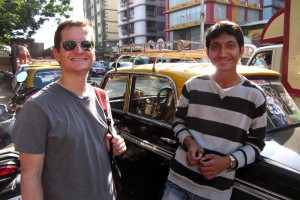
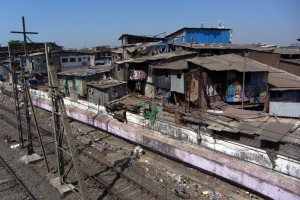

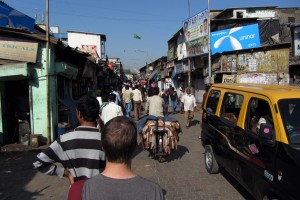
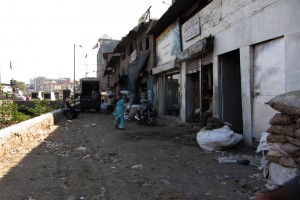
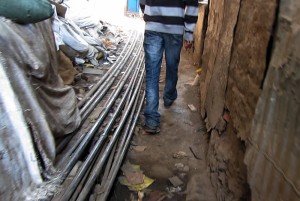
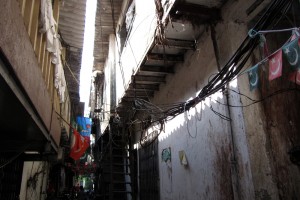
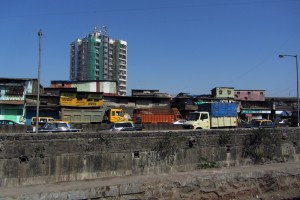


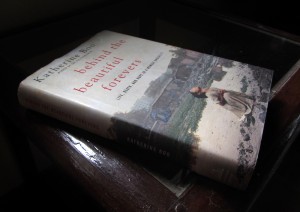
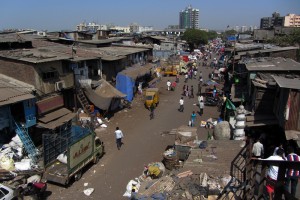
Wow! That is soooo interesting Ken. What an experience! I don’t know tho – people don’t ONLY think about beer when they think about Milwaukee, remember Dahmer?!?!?! That’s always (unfortunately) a favorite subject too!!!